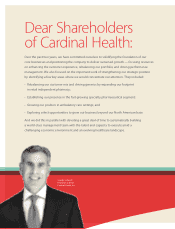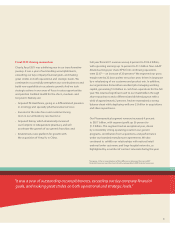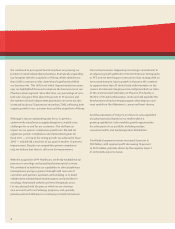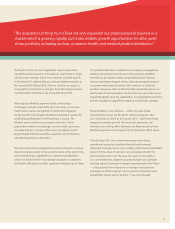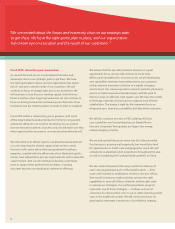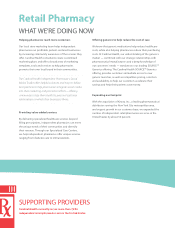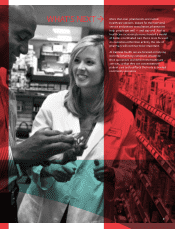Cardinal Health 2011 Annual Report Download - page 6
Download and view the complete annual report
Please find page 6 of the 2011 Cardinal Health annual report below. You can navigate through the pages in the report by either clicking on the pages listed below, or by using the keyword search tool below to find specific information within the annual report.
We continued to put a great deal of emphasis on growing our
position in retail independent pharmacy, dramatically expanding
our footprint with the acquisition of Kinray, which added more
than 2,000 customers to this channel and signicantly shifted
our business mix. This shift is not trivial. Approximately two years
ago, we highlighted the need to improve the business mix in our
Pharmaceutical segment. Since that time, our percentage of non-
bulk sales has gone from about 50 percent to 57 percent, and
the number of retail independent pharmacies we serve has also
increased by about 50 percent to more than 7,000, reecting both
organic growth in our customer base and the acquisition of Kinray.
Although it was an outstanding year for us in generics,
system-wide manufacturer supply disruptions created some
challenges for us and for our customers. This did have an
impact on our generic compliance growth rate. We had set
aggressive generic compliance rate improvement goals for
scal 2011 — on top of the strong growth we achieved in scal
2010 — and did fall a bit short of our goal of another 10 percent
improvement. Despite our competitive generic compliance
rate, we believe that there is still room for improvement.
With the acquisition of P4 Healthcare, we rmly established our
presence in oncology and specialty pharmaceutical services.
We continued to build out our capabilities in clinical pathways
management, giving us greater strength with new sets of
customers and partners upstream, and enabling us to build
collaborative relationships between payors and providers in
oncology, rheumatoid arthritis and new therapeutic areas.
I’m very pleased with the pace at which we are winning
new accounts with our Pathways programs, and specialty
pharmaceutical distribution is continuing to build momentum.
Our nuclear business stepped up its strategic commitment to
an adjacent growth platform in Positron Emission Tomography,
or PET, and we have begun to execute on that strategy with an
eye toward dynamic future growth in that area. We continue
to support more than 20 clinical trials with innovators in the
science of molecular imaging and recently launched our state-
of-the-art innovation laboratory in Phoenix. This facility is
the rst-of-its-kind collaboration center and will expedite the
development of nuclear imaging agents that diagnose and
treat conditions like Alzheimer’s, cancer and heart disease.
And the acquisition of Yong Yu in China not only expanded
our pharmaceutical business in a market which is
growing rapidly, but it also enables growth opportunities
for other parts of our portfolio, including nuclear,
consumer health, and medical product distribution.
Our Medical segment revenue increased 2 percent to
$8.9 billion, with segment prot decreasing 14 percent
to $370 million, primarily driven by the negative impact
of commodity price increases.




